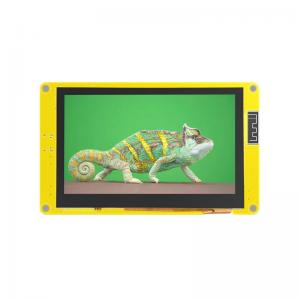



Add to Cart
| Size | 4.3 inch |
| Type | TFT |
| Driver chip | ILI9485 |
| Resolution | 800*480(Pixel) |
| Effective display area | 95.04* 53.86(mm) |
| Module size | 105.5*74(mm) |
| View | >60° |
| Operating temperature | -20℃~70℃ |
| storage temperature | -30℃~80℃ |
| Operating Voltage | 5V |
| Power consumption | About 260mA |
| Product weight | About 130g |
The ESP32 4.3 inch color LCD display module has the following
advantages:
1. High resolution screen: This display module has a
high-resolution screen with a resolution of 800 * 480 IPS, which
can provide clearer and more vivid images and video effects.
2. Touch screen function: This device also has touch screen
function, which can be input using fingers or stylus, achieving
more convenient user operation.
3. Support for Bluetooth and WiFi connections: This device supports
Bluetooth and WiFi connections, making it easy to connect to the
network and other devices for remote control and data transmission.
4. Open design: The device also has an open design that can be
easily integrated into various customized applications.
5. Multiple programming languages and development environments:
This device supports multiple programming languages and development
environments, such as Arduino, MicroPython, Visual Studio Code,
etc., making it easy to program and integrate into different
systems.
FAQ
What SD cards are supported by the SDIO/SPI interface of ESP32?
SDSC card: Standard capacity SD card with a capacity of 2GB or
less.
SDHC card: High capacity SD card with a capacity between 2GB and
32GB.
SDXC card: Expansion capacity SD card, with a capacity between 32GB
and 2TB.
How do TFT LCD modules work?
TFT LCD modules work by using a backlight to illuminate the display
and using a matrix of thin-film transistors to control the color
and brightness of each pixel. The transistors are controlled by a
controller chip, which receives signals from a microcontroller or
other source.
What is the difference between TFT LCD and OLED displays?
TFT LCD displays use backlight to illuminate the display, while
OLED displays use organic compounds to emit light. OLED displays
provide better contrast and color reproduction, but they are more
expensive and have a shorter lifespan compared to TFT LCD displays.
